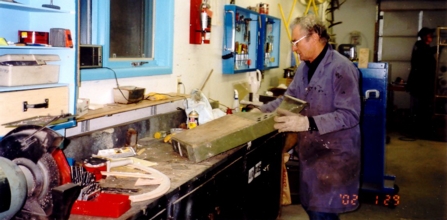 Museum
Museum  |
Bomber Command
|
Aircrew Chronicles
|
Aircrew Losses
|
Nose Art
|
BCATP
|
Lancaster
|
Media
|
Bomber Command
|
Aircrew Chronicles
|
Aircrew Losses
|
Nose Art
|
BCATP
|
Lancaster
|
Media
 Museum
Museum  |
Bomber Command
|
Aircrew Chronicles
|
Aircrew Losses
|
Nose Art
|
BCATP
|
Lancaster
|
Media
|
Bomber Command
|
Aircrew Chronicles
|
Aircrew Losses
|
Nose Art
|
BCATP
|
Lancaster
|
Media
Bomber Command Museum Archived Newsletters
|
The Society's main event this year will be a salute to the wartime British Commonwealth Air Training Plan. In attendance will be a number of veterans who trained or instructed in this vast undertaking that graduated some 130,000 aircrew from 1940 to 1945. There will be the displays from visiting aviation groups and individuals, with model aircraft, aviation paintings, etc. One of the highlights of this special day will be the official dedication of the 1:72 scale model of the #5 Elementary Flying Training School as it existed at High River, Alberta in the 1940's. This model had been under construction over the last three years, by Larry and Debra Kunz of St. Gregor, Saskatchewan, who donated it to the museum. As usual we will have a fly-past of vintage aircraft. This will take place near the end of the day just prior to the evening banquet. Details of the day's agenda, will be mailed to all members in June with details of the day's itinerary and banquet ticket costs. We look forward to a large turnout for this event and encourage all our members to join us on August 24, 2002. |
 (EFTS), High River, Alberta dates to the period when the Tiger Moths were still in use. This photo was taken from a position north of the base. |
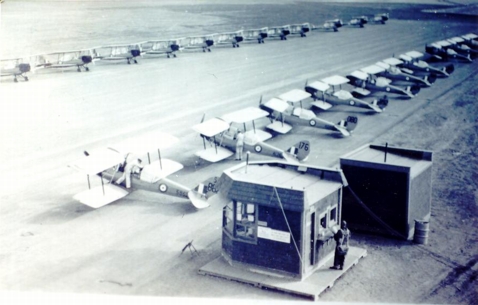 |
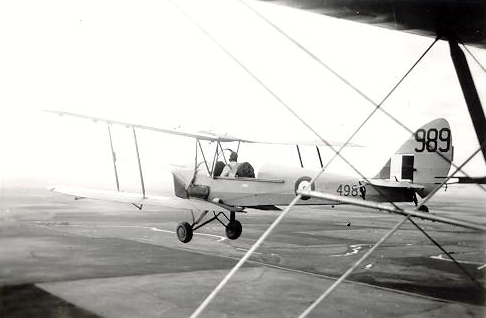 during flight training circa 1942. |
Nearly three years ago Larry Kunz of St. Gregor, Saskatchewan, e-mailed us after visiting the MuseumŐs website. He asked if we would like a model built of one of the BCATP bases in Southern Alberta and that he would do this for the cast of the materials and transportation to Nanton when it was completed. We immediately accepted his offer and chose the High River, #5 Elementary Flying Training School (EFTS). This model is now on display in the museum. Larry, wife Debra, and son Bryce, delivered the crated parts of this 1:72 scale recreation of the High River base, on April 2/02, and installed it on a table that local volunteers had made to accommodate it. (A Plexiglas cover is being constructed to cover the model). We think the new display is a tremendous addition to the BCATP theme! we extend a most GRATEFUL THANKS to Larry and Debra Kunz for adding so much to our museum ! |
 standing with the model #5 EFTS, High River, built by Larry over the past three years. |
The 480 sq. ft. expansion to the museum front entryway is now competed except for the exterior stucco, which should be completed by the end of May, 2002. While the addition is not a large area, it has made a tremendous difference to the area as the visitor enters the museum. The additional wall space has made room for some spectacular new wall displays. The floor area will be kept relatively clear except for a couple of medium-sized artifacts and a "greeter" in full wartime dress uniform.
|
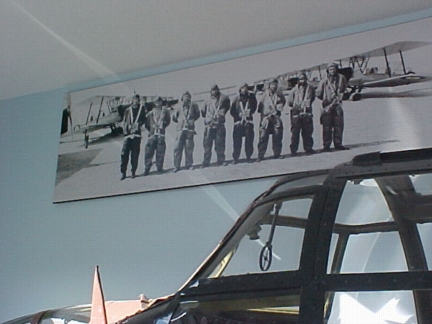 in the new entryway. |
The museum's main gallery has been subject to some changes in the last month. The area that had been previously designated to the British Commonwealth Air Training Plan (BCATP) in conjunction with other smaller displays is now totally dedicated to this theme. The model of #5 EFTS has been the main addition and integrating it into the area made it necessary to change the position of other items. Another addition to the BCATP display will be a photographic treatise of the #19 Service Flying Training School (SFTS) which is located 19 miles east of Nanton, near Vulcan, AB. The photographs are the work of local RCMP officer, Danny Palmer, whose hobby is photography. The daily dispatch blackboard from #19 SFTS, which has the names of the second last class to graduate from #19 in 1945 and of their instructors written in the original chalk, is still part of the display. Photos and a short written history of this base will be added in the next few weeks. |
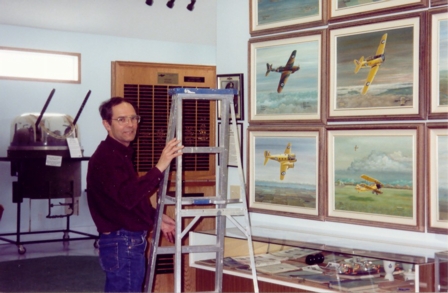 |
In December Bruce Winters of the Okotoks Air Park contacted us about the T-33 that has been mounted on a plinth near the Okotoks airport for a number of years. Bruce wanted it removed as it was in the way of housing development. Your Society now owns the aircraft and has placed it on long term-loan with the Rocky Mountain House Flying Club (RMHFC). Society member, Maurice Galli, who is also a member of the flying club, helped to formulate the loan agreement. This Flying Club is a "gung-ho" group; they removed the T-33 from its pedestal and hauled it to "Rocky" in one day! They are presently cleaning and repairing the aircraft for mounting it at the Rock airport sometime in May. |
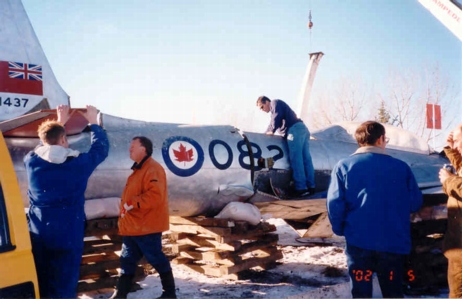 by members of the Rocky Mountain House Flying Club. |
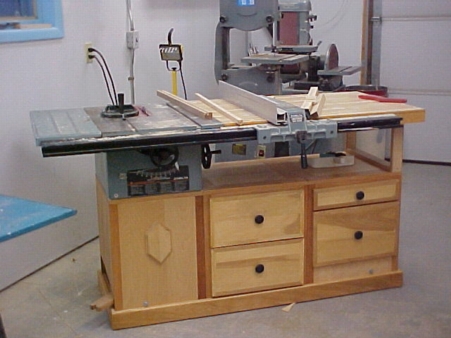 Quality that could fit into a living room. |
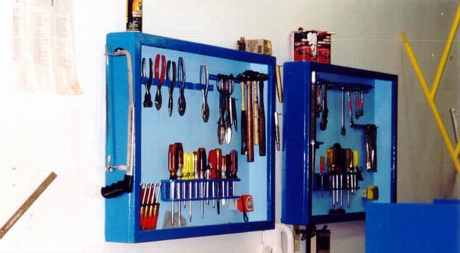 Your Society is indebted to all volunteers who dedicate Tuesday nights (and sometimes weekdays) to the numerous projects. |
|
Due to the generosity of one of our members, we now have a full 110 feet of door installed. Our museum's good friend Alex Bahlsen donated a substantial sum of money towards the purchase of the additional hangar door sections. With this incentive, your Society went ahead with this project which otherwise was slated for two years hence. Actually, the word "door" is a bit misleading, as there are in fact five doors involved. The hangar was originally equipped with the 22-foot wide centre door. All doors are of the roll-up type. The tracks are split and the "pillars" (with the lower roller track sections attached) between the doors roll off to one side after the doors are raised, leaving a clear span large enough to roll the Lancaster out! for moving smaller aircraft in or out, only two or three of the five doors are opened. the Society extends a grateful THANKS to Alex Bahlsen for his generous contribution that has resulted in the completion of the hangar and making it possible to move aircraft in an out for special day demonstration, etc. |
 |
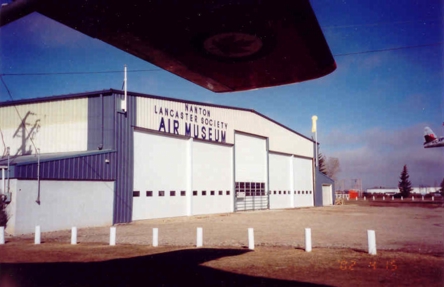 The museum hangar with all five doors installed as of April 16, 2002. The Lancsater could now be "rolled out". |
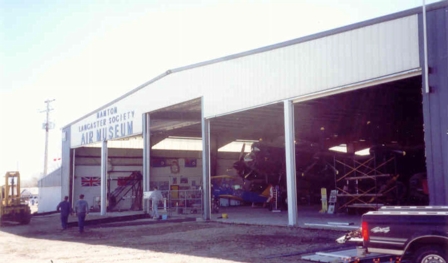 The museum hangar fully open for the first time since the Lancaster was pulled into the building in May 1991. The pillars seen in place here for lowering the doors. |
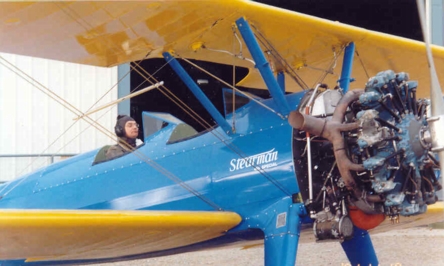 with his Stearman. |
 |
|
Since the Fall 2001 newsletter was sent out some changes have taken place in contemplated work for the shop over winter. The progress note regarding the N.A. Yale stated that the engine and wing centre-section for the Yale would likely be the next items due for restoration. A review of this project in December resulted in these items being relegated to the back burner and the Yale rear fuselage section being brought into the shop instead. Also contributing to this change was the willingness of our AME volunteer Greg Morrison, to undertake the restoration of this component over winter. It was also decided to restore this part of the aircraft to an airworthy standard due to its relatively good condition (other than the skin). With volunteer work being done by Greg, the costs of certified materials being little more than those used for static restoration made this feasible. The accompanying photos will hopefully give the reader some idea of the progress up to late March. Our Society is grateful to Greg for his dedication to this project. Thanks also to Bob Long and John Phillips AME, who are assisting Greg with this restoration. |
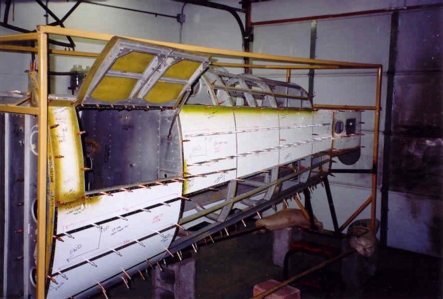 |
|
Since the last news letter most of the fuselage formers are made and three floors finished. The Navigator floor is well along. Drawings for this floor were unavailable. Harry Volk, drew up a set of drawings from the remains of several navigator floors. The solid plywood cockpit floor will be replaced with an authentic framed floor. Complete drawings did not exist for this floor either. Thanks to locating a fairly complete original floor a a pattern, Harry's drafting talents have now created a drawing that will allow us to construct a cockpit floor as in the original Ansons. Warmer weather to allow us to work in the hangar and mount the formers sand floors on "Annie." In the mean time volunteer Jack Hicks, Charles and Hugh Logie, Krysta Pedersen, Richard Adams, John Green, and myself have been busy sorting and cataloging parts, making formers, and rebuilding the crew door. Thanks to all the volunteers for their dedication to this project. |
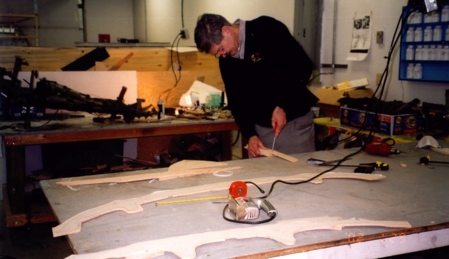 |
Ken Townend, Western Canada representative of the Canadian Branch of the Yorkshire Air Museum (YAM), presented a framed, limited edition of a print featuring the Halifax "Friday The 13th." This print is from an original painting by John Moutray DFC, DFM, and is titled "Trouble over Texel." Ken presented this on behalf of the Yorkshire Air Museum and Douglas Sample, CD, president of their Canadian branch. This print will be added to the museum's Halifax display. The Society extends a grateful THANKS to Ken Townend, Douglas Sample and the Yorkshire Air Museum for enhancing this display. |
 to NLS curator Bob Evans. It will be added to the Halifax display seen here in the background. |
|
One of the projects underway in the shop is the restoration of a Bristol Turret from the Blenheim (Bolingbroke) bomber. Volunteer Charlie Cobb, who drives from Calgary nearly every "Tuesday work night,"" is in charge of this project. The late Buck Koral was assisting him. The museum has two such turrets. One is presently installed (unrestored but complete with imitation machine guns) in the restored Blenheim that is on display in the hangar. Your Society hopes to eventually restore both turrets. One will be used as a display unto itself to show visitors the workings of this 1930's design. The other will be refitted to the Blenheim. Thanks to Charlie for his dedication to this project and the museum. |
 |
 |
A sixty page book chronicling the history of the museum's Lancaster will soon be printed. It begins by describing the aircraft's early years as it flew to England after the war ended and then returned to Canada only to be placed in long-term storage in southern Alberta. FM159Ős travels during the 1950s while based at Greenwood, Nova Scotia, with 103 Rescue Unit and at Comox, B.C., with No. 407 Squadron are described. With the cooperation of former RCAF personnel who flew the post war Lancasters, many stories and photographs have emerged regarding flights to Ireland, Florida, Alert, California, and Alaska. The book goes on to tell the story of how FM159 was acquired by three Nanton residents and later became the centrepiece of an air museum as the Ian Bazalgette Memorial Lancaster The book is the result of two years of research by NLS director, Dave Birrell, who has previously authored the book, "BAZ," the story of S/L Ian Bazalgette VC, to whom the museumŐs Lancaster is dedicated. Dave has also published two books about the Rock Mountains. |
The photo below is that of a simulator fuselage which was donated to the Nanton Lancaster Society Air Museum by the Canadian Warplane Heritage (CWH) Museum, Hamilton, Ontario. CWH had acquired as number of these ŇP-51sÓ and offered some of them to members of the Canadian Aeronautical Preservation Association (CAPA) members at that organizationŐs convention last fall. NLS will be adding a computer with the Flight Simulator program to this for a hands-on display for visitors, both young and older. NLS extend THANKS to the Canadian Warplane Heritage Museum for this donation and also to the Calgary Aero Space Museum for transporting it along with some of these same simulator bodies acquired by their museum. Last but not least, THANKS to two NLS directors; Jim Weirsma for making a trip to Calgary to pick up the fuselage, only to find that it would not fit in his short box pickup truck; and to director John Phillips for finally hauling it. |
 |
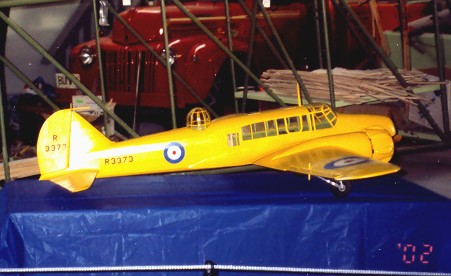 Large Anson Mk.I model donated by Don bowhay, Airdrie, AB. It was built as a radio controlled model but was never flown. |
 Alex Bahlsen's Stearman has been on display in the museum all winter. It was the first aircraft out the new hangar doors. |
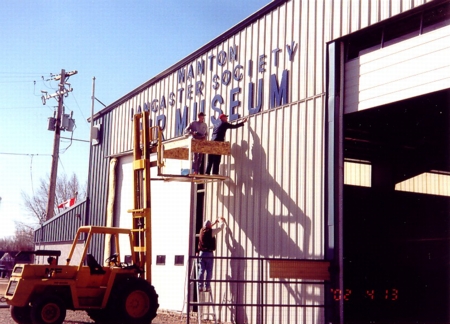 Directors, Greg Morrison and Eric Bryant stand on the man-lift, while director Jim Weirsma uses a ladder. All thtree are in the process of removing the walls that have covered the hangar door area since 1991. The additional doors, now installed, were installed inside with the walls in place, so the building was never open to the weather. The final weather stripping, etc., was added after the walls were dismantled. Removing the sheet metal and wall framework was an "all volunteer" undertaking. Several other Society member also spent a full day getting this done. The Society is very pleased with the work of the contractor, "The Door Doctor," Dave Gourley, and his crew. THANKS to DAVE, NEIL, and JO ANNE for a job well done! THANKS also to MAGWOOD MOTORS for the use of their forklift in removing the walls!. |
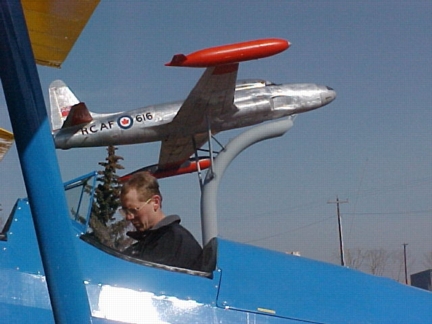 AME Greg Morrison in the cockpit of Alex Bahlesen's Stearman, April 20, 2002. It was the first aircraft to be moved out of the museum via the new hangar doors. the Museum's T-33 in the background. 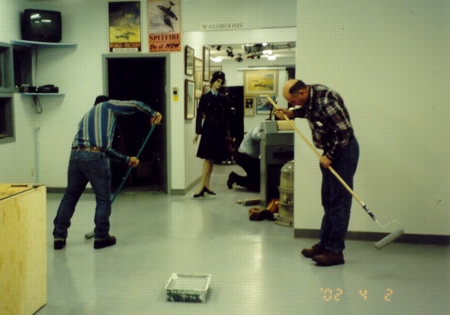 Members of the Society are often asked, what is the secret of our success. We belive the old saying that a lot of organizations fail becouse they have "too many cheiefs and not enough workers." An example of our attitude is that even our president, will take on the menial jobs. Here is President Dan Fox, shown above (left) with member/volunteer Maurice Galli (right). They are painting the main gallery floor, after first sweeping and washing it. The uniformed "lady" in the background is supervising. |
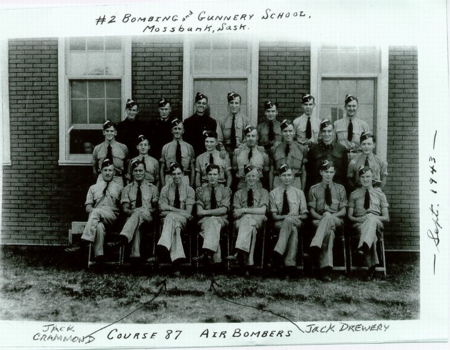
Jack Ccrammond's photo of the September 1943 graduates of Course 87 at
#2 Bombing and Gunnery School, Mossbank, Saskatchewan.
Jack is third from theh left in the front row. Jack Drewery is next to him (4th).
